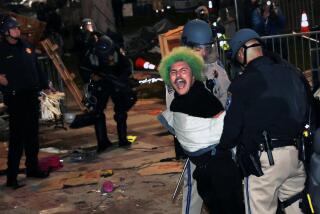Police Caught Off Guard by Magnitude of Turmoil, Experts Say
- Share via
WASHINGTON — Seattle police, thrust into the international spotlight by the chaotic protests at the World Trade Organization conference, failed to adequately predict the size, strength or potential violence of the thousands of demonstrators, law enforcement experts said Wednesday.
“It seems clear that the police just didn’t have the intelligence information they needed to put together a good plan and to ensure safety and minimize disruption,” said Jim Pasco, head of the 283,000-member National Fraternal Order of Police.
Law enforcement officials said the violence in Seattle could serve as a wake-up call for Los Angeles, which is lagging in planning for next year’s Democratic National Convention--another high-profile event that could draw wide-scale protests.
The Los Angeles Police Department, in fact, dispatched several officers to Seattle to see what has worked there--and what hasn’t. The lessons could be sobering.
“Clearly, this was a learning experience for everyone, and it will be analyzed for our own preparations” for the Democratic convention, said Cmdr. David J. Kalish, an LAPD spokesman.
Los Angeles convention organizers want to establish a single large area for protesters--visible to television cameras but removed from key traffic patterns and areas of potential disruption, said a planning official who asked not to be identified.
“I don’t think we’ll allow [protests] to get out of hand,” the official said. “But what we’ve seen in Seattle tells us we need to be even more alert.”
The relatively small size of Seattle’s 1,230-officer Police Department, compared with New York, Washington, Los Angeles or other cities that are often the targets of political demonstrations, may have left officers overwhelmed. And police were up against an unusually wide variety of causes, rather than single-issue protests over abortion, civil rights and the like.
In the nation’s capital, where political protests are as common as pork-barrel spending bills, police say the key to controlling events is knowing what demonstrators plan to do. District of Columbia police even use informants and undercover officers to gather intelligence, getting the jump on surprise
protests or tactics, said Lt. Larry Sumpter, head of the civil disturbance unit.
“I’m not knocking [Seattle police], but I just wonder how much preparation went into that,” Sumpter said. “I mean, how often does Seattle have to handle something like this?”
With tens of thousands of demonstrators representing organized labor, environmental movements and human rights groups, events at the WTO conference turned ugly Tuesday. Some protesters began breaking windows and denying delegates access to events, drawing rounds of tear gas from police and prompting Washington Gov. Gary Locke to call in the National Guard.
Protests continued Wednesday with hundreds of arrests, but large swaths of downtown Seattle were blocked off, allowing police greater control of the situation.
Police and city officials in Seattle acknowledged that the melee, which generated headlines around the world, was a major embarrassment and that they were largely ill-prepared for it.
Seattle police said their advance work was extensive. They budgeted millions of dollars in overtime, bought tear gas, conducted training sessions on civil disturbances and sent business owners a memo on how to take precautions, such as covering their windows with plywood to protect against shattering.
But police said their threat analysis produced little indication that protesters might turn violent, even though the WTO’s previous meeting, in Geneva, was marred by demonstrators who overturned cars and set fires.
“These are always difficult situations for the police,” said Joseph McNamara, a former police chief in San Jose who is a research fellow in law enforcement at Stanford University’s Hoover Institution. “Police have a fundamental duty to protect the right of free speech and preserve the rights of people to use the streets, and there’s a real conflict there.”
Often, demonstrators cooperate with authorities, applying for permits and telling police what they plan to do and whether any of their members plan to be arrested in a show of civil disobedience. But McNamara and other law enforcement officials say extreme dissenters often mislead police about their tactics, trying to goad them into a televised confrontation.
“You have to emphasize patience,” said Sumpter in Washington, noting that District of Columbia police have shut down a major bridge at rush hour for a demonstration rather than risk violence. The use of tear gas or other chemical munitions is a last resort that police in the capital haven’t used to quell a political protest since the 1970s, he said.
“I think there are a lot of lessons to come out of this” for authorities in Seattle and other cities hit with political demonstrations, said Hubert Williams, president of the Police Foundation, a nonprofit research group in Washington, D.C. “Police are going to have to redouble their efforts to get as much information as they can on who the protesters are--their numbers, their tactics and their agenda. . . . The police never have all the information.”
More to Read
Get the L.A. Times Politics newsletter
Deeply reported insights into legislation, politics and policy from Sacramento, Washington and beyond. In your inbox twice per week.
You may occasionally receive promotional content from the Los Angeles Times.










